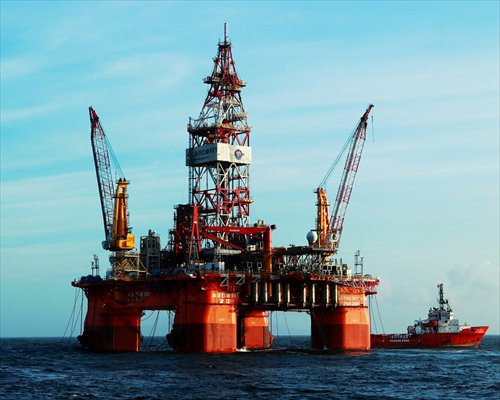HOME >> CHINA
Mobile oil drill opens up South China Sea reserves
Source:Global Times Published: 2015-12-6 19:33:01

HYSY-981 is towed in the South China Sea. Photo: courtesy of CNOOC
As China's first domestically built mobile deepwater drilling platform, HYSY-981 draws the world's attention whenever it makes moves in the South China Sea.The drilling rig was paid for by the China National Offshore Oil Corp (CNOOC) and it took the China State Shipbuilding Corp three years to build. Since starting its first drilling operation in 2012, HYSY-981 has drilled 18 oil wells.
As Su Guifeng, deputy director of the news center of the Assets Supervision and Administration Commission under the State Council said, HYSY-981 represents the development of the industry and shows China's overall accomplishment in the high-end equipment manufacturing industry.
To keep stable on the turbulent sea, especially in deep waters, HYSY-981 uses anchor-moored and dynamic positioning together, an employee from the rig's control room told the Global Times.
Anchor-moored positioning is used in waters up to 1,500 meters deep while in 3,000-meter-deep waters, HYSY-981 uses statistics from satellite positioning systems to balance itself.
The rig utilizes high-horsepower thrusters and when its eight diesel-driven 40,000-gigawatt generators are running, they generate an amount of electricity equal to that used by a middle-sized city.
This power system allows HYSY-981 to move without towboats when it needs to evade typhoons or change position.
It took the rig 31 days to travel the 4,600 kilometers to the Bay of Bengal to start its first overseas mission in January and accomplished it in April, with an operational efficiency of 99.09 percent.
Operational efficiency is an important indicator used to measure the performance of an offshore drilling platform as the cost of drilling in deep waters is seven times as much as in shallow waters and once a project starts, it cannot stop.
Operational efficiency is a way to measure how much time the rig spends idle on a mission. An operational efficiency of 99 percent means that it only spent 1 percent of its time not working, on account of equipment changes, bad weather or other problems.
HYSY-981 reached an operational efficiency of 93 percent on its first operation, higher than the industry average of 80 to 85 percent. And in 2013, it set a record for drilling in deep waters with a 97.5 percent operational efficiency.
China's previous maritime oil extraction capability was limited to waters 500 meters deep, while HYSY-981 allows the nation to expand into the deeper and oil-rich waters of the South China Sea.
According to statistics issued by the resource department in 2010, there are about 23-30 billion tons of oil and 16 trillion cubic meters of gas under the South China Sea, amounting to one third of the total oil and gas resources of the country.
A recent document released by the State Council attached importance to developing the marine engineering manufacturing industry to meet the needs of offshore industries in China and effectively promote the overall power of related sectors, such as domestic shipbuilding and metallurgy industries.
Zhou Shouwei, a deputy general manager of CNOOC, was quoted as saying that, "A deepwater drilling rig is a basic platform to realize the sustainable development of ocean energy industry. It is an important part of China's large industrial equipment as well as an important symbol of China's overall strength." The drilling rig is now operating in the Lingshui area of the South China Sea.
Controversy on the waves
While the mobile rig has been successful in all its operations so far, at least one of its drilling trips has been risky.
On May 2, 2014, HYSY-981 started its drilling operation in China's Xisha Islands. Shortly after the operation started, Vietnam sent a large number of ships, including armed vessels to the site to disrupt operations and ram Chinese vessels on escort and security missions.
According to China's Ministry of Foreign Affairs, Vietnam sent frogmen and other underwater agents to the area, and dropped large numbers of obstacles, including fishing nets, in the waters. As of June 7, there were as many as 63 Vietnamese vessels in the area, attempting to break through China's cordon and ramming Chinese ships a total of 1,416 times.
China insisted that the drilling rig was continuing explorations that had gone on in the related waters for the past 10 years, and th at its activities fell well within China's sovereignty and jurisdiction.
The incident caused an increase in tensions between Vietnam and China and a series of anti-Chinese riots across the Southeast Asian country in which Chinese businesses were attacked, looted and burnt down. Singaporean, South Korean and Malaysian businesses also came under attack by rioters who mistook them for Chinese. Eventually around 3,500 Chinese workers were evacuated after two Chinese nationals were killed in Vietnam and at least 100 injured in protests, Xinhua reported.
Newspaper headline: Going deeper
Posted in: Society